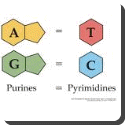 Deoxyribonucleic acid (DNA) is the genetic material found in the chromosomes of all animals and plants. It is made up of only four types of organic nitrogenous bases: adenine (A), guanine (G), thymine (T) and cytosine (C). Of these, A and G are the purines and T and C are the pyrimidines. Chargaff gave the base pairing rule or the rule of base equivalence which states that only one purine can combine with one pyrimidine. That means A can combine with T and G with C. Two purines or two pyrimidines cannot combine with each other; if they do so, there will be a sudden change in the characteristic of an organism. This sudden change is called mutation.
Deoxyribonucleic acid (DNA) is the genetic material found in the chromosomes of all animals and plants. It is made up of only four types of organic nitrogenous bases: adenine (A), guanine (G), thymine (T) and cytosine (C). Of these, A and G are the purines and T and C are the pyrimidines. Chargaff gave the base pairing rule or the rule of base equivalence which states that only one purine can combine with one pyrimidine. That means A can combine with T and G with C. Two purines or two pyrimidines cannot combine with each other; if they do so, there will be a sudden change in the characteristic of an organism. This sudden change is called mutation.
Check Also
साप्ताहिक लव राशिफल मई 2025: ऐस्ट्रॉलजर नंदिता पांडेय
साप्ताहिक लव राशिफल 12 – 18 मई, 2025: आइए जानते हैं ऐस्ट्रॉलजर नंदिता पांडे से …
 Kids Portal For Parents India Kids Network
Kids Portal For Parents India Kids Network






